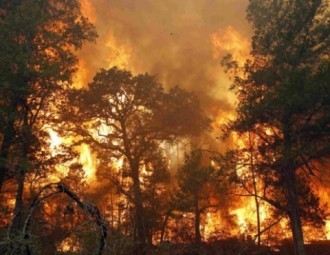After a wildfire at Chernobyl site fire was fully distinguished

However, environmentalists claim that the smoke from wildfires may be dangerous and lead to secondary radioactive contamination of adjacent areas.
The radiation level is safe in the Chernobyl Nuclear Power Plant Exclusion Zone where a forest fire broke out on Tuesday, Zoryan Shkiryak, the acting head of Ukraine's emergencies service said on Wednesday.
"The background radiation level is normal, there is no threat," said.
He said the fire had been localised and the situation was under control, adding that aircraft were dumping water on the flames.
Ukrainian Prime Minister Arseny Yatseniuk also claims that the wildfire situation near the site of the 1986 Chernobyl nuclear disaster is under control.
"The fire situation has stabilised and the radiation levels in the fire zone and Kiev are normal, - he said. – There is no threat to local residents and those involved in the firefighting effort."
Local officials told TASS earlier that fire broke out on Tuesday in the southern, less contaminated part of the Chernobyl Exclusion Zone but the blaze has almost reached "the area which was more contaminated after the Chernobyl NPP disaster."
Russian experts have disagreed about the possible radiation hazard for the residents of areas close to the Chernobyl nuclear power plant exclusion zone as a result of wildfires there.
Thus, Leonid Bolshov, Director of the Nuclear Safety Institute of the Russian Academy of Sciences, says that radioactive substances in the Chernobyl NPP exclusion zone can no longer get into the atmosphere, since for the time elapsed since the nuclear plant accident, they have gone deep into the soil. There is no radiation danger, he said.
"In 2010, when Russia, in particular, its Bryansk region, was swept by wildfires, we carried out a detailed research, - Bolshov said. – The conclusion of these studies is that changes in background radiation below the registration level we unnoticeable. We’ve now checked it with the sensors in Pripyat, near the Chernobyl NPP - no change for two days. The reason for this is that over the past 30 years, radiation - that has not decayed naturally, has gone deep into the soil."
However, head of the WWF Forest Programme Nikolay Shmatkov says that the situation is far from ideal. According to him, the smoke from wildfires may be dangerous and lead to secondary radioactive contamination of adjacent areas.
"Forest fires in areas of radioactive contamination are dangerous in principle, - said Shmatkov, - because the radioactive substances contained in the wood have not yet gone deeply into the soil and may get into the air with the smoke from the burning forest. Then the wind may carry these substances to long distances."
According to previous reports, a wildfire in the Chernobyl NPP exclusion zone in Ukraine occurred in the evening of April 28 - a landscape park at an area of ·· 240,000 hectares caught fire. The Ukrainian Interior Ministry in the Kiev region opened a criminal case over the fire. Ukraine’s State Emergencies Service does not exclude an arson version. The situation stabilised on Wednesday afternoon.
Wednesday evening the forest wildfire has been fully put out, the press service of Ukraine's Emergencies State Service reported.
-
03.01
-
07.10
-
22.09
-
17.08
-
12.08
-
30.09



























